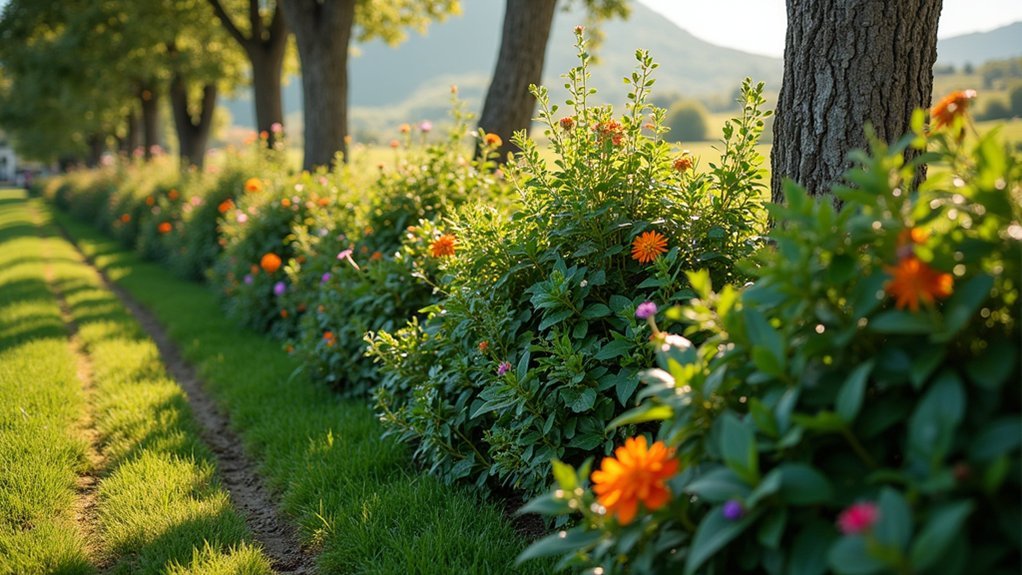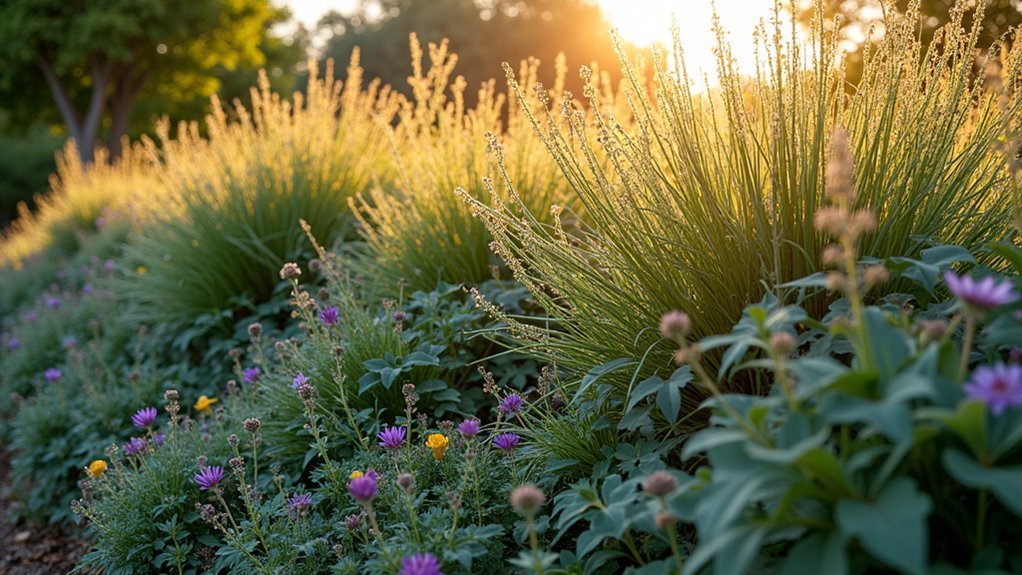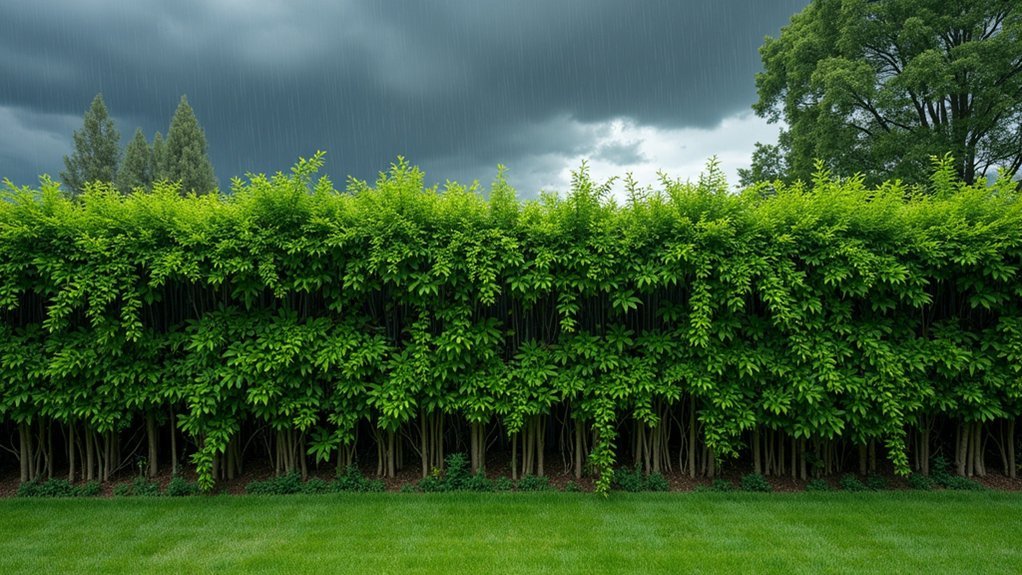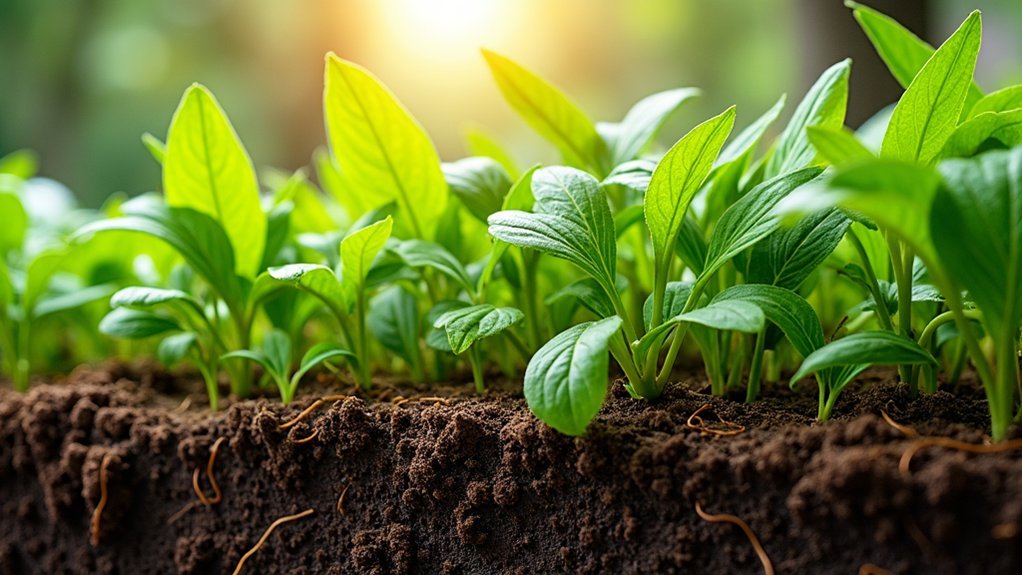Climate-resilient living fences offer impressive advantages over traditional fencing. They reduce soil erosion by up to 50%, capture 600-800 pounds of carbon annually, and create essential wildlife habitats. You’ll save considerably on maintenance costs while enhancing property value. These natural barriers thrive in harsh weather, conserve water, and can cut your water bills by half with drought-tolerant varieties. Discover how these sustainable boundaries can transform your landscape while protecting against increasing climate challenges.
Understanding Climate-Resilient Living Fences as Adaptive Landscape Solutions

As climate change intensifies global weather patterns, climate-resilient living fences offer homeowners a practical, sustainable alternative to traditional fencing methods.
These innovative boundaries consist of native species that are naturally adapted to your local environment, enabling them to withstand extreme weather fluctuations.
Unlike conventional fences, living fences work with nature rather than against it. Their extensive root systems reduce soil erosion by up to 50%, particularly valuable for properties on slopes.
Living fences embrace natural systems, with roots that halve erosion risk—especially beneficial for hillside properties.
You’ll contribute to carbon sequestration too, as mature hedgerows can capture 600-800 pounds of carbon annually.
Beyond environmental benefits, these adaptive barriers create habitats for wildlife and pollinators, fostering biodiversity in your yard.
Key Environmental Benefits of Weather-Resistant Plant Barriers
While traditional fencing materials deteriorate in harsh weather, climate-resilient living fences actually thrive and provide substantial environmental benefits.
By using native species adapted to local conditions, you’ll conserve water resources and reduce maintenance needs.
These natural barriers capture 600-800 pounds of carbon dioxide annually, directly contributing to climate change mitigation while improving air quality by filtering pollutants.
You’ll notice enhanced soil stability as their root systems prevent erosion during heavy rainfall and temperature fluctuations.
Perhaps most importantly, your climate-resilient fence supports biodiversity by creating habitats for pollinators and beneficial insects.
This ecosystem support strengthens your property’s resilience against changing climate conditions while providing a beautiful, functional boundary that works with nature rather than against it.
Top Native Species for Drought-Tolerant Living Boundaries

When choosing native species for your drought-tolerant living fence, you’ll benefit from plants already adapted to your region’s specific climate conditions.
Consider low-maintenance options like juniper, barberry, and desert willow, which require minimal water and resources once established while considerably reducing ongoing maintenance costs.
These climate-resilient boundaries also enhance local biodiversity by providing essential food and shelter for wildlife, creating a functional ecosystem that supports native fauna.
Regional Adaptation Benefits
The strategic selection of native species for living fences delivers exceptional climate resilience across diverse geographic regions.
When you choose plants naturally adapted to your area’s rainfall patterns, you’re investing in boundaries that will thrive with minimal intervention. These drought-tolerant barriers establish deeper root systems that stabilize soil during both wet and dry periods, preventing erosion that commonly affects conventional fencing.
Your native living fence creates valuable habitat for birds and other wildlife that conventional barriers simply can’t provide.
Species like desert willow in southwestern regions or juniper in mountain areas offer climate-resilient solutions specifically matched to local conditions.
Low-Maintenance Plant Options
Building a climate-resilient barrier starts with selecting the right plant species that can withstand harsh conditions while requiring minimal care. Native drought-tolerant plants offer you reduced long-term maintenance benefits while creating effective living boundaries.
| Species | Benefits | Maintenance Needs |
|---|---|---|
| Juniper | Extensive erosion control | Annual light pruning |
| Barberry | Wildlife habitat, security | Minimal watering |
| Sagebrush | Soil health improvement | No fertilization needed |
| Rabbitbrush | Pollinator attraction | Self-sustaining growth |
When you choose these low-maintenance native species, you’ll save time and resources. Their deep root systems prevent soil erosion on slopes, while their natural adaptation to local conditions means they’ll thrive without constant attention. These drought-tolerant plants require less frequent watering, pruning, and pest management compared to non-native alternatives, making them ideal for sustainable landscapes.
Wildlife Habitat Enhancement
Creating wildlife-friendly boundaries doesn’t require sacrificing drought tolerance or maintenance convenience. Native species like California lilac and desert willow thrive in arid conditions while providing essential wildlife habitat enhancement opportunities.
Honey mesquite offers dual benefits – surviving with minimal water while producing edible pods that support wildlife like birds and small mammals.
For maximum biodiversity, incorporate purple sage to attract critical pollinators such as bees and butterflies.
The resilient creosote bush creates valuable microhabitats, offering both food and habitat for insects and smaller creatures.
By choosing a diverse mix of deep-rooted native plants, you’ll improve soil stability while fostering a thriving ecosystem.
These climate-smart choices create living boundaries that not only withstand drought conditions but actively contribute to local wildlife conservation efforts.
Designing Multi-Layered Fences for Extreme Weather Protection

When designing multi-layered fences for extreme weather protection, strategic plant selection and arrangement create resilient barriers that withstand nature’s harshest conditions.
Living fences offer superior protection when you combine fast-growing plants like juniper with moisture-loving native species, while considering your local soil conditions.
The strategic pairing of juniper with native moisture-lovers creates living barriers that thrive in your unique soil while offering exceptional weather protection.
Your multi-layered fence will maximize protection through:
- Height and density variation – reducing wind speed by up to 30%
- Strategic placement of thorny outer plants with delicate inner varieties
- Diverse species selection to prevent complete fence failure during pest outbreaks
- Incorporation of deep-rooted plants that reduce erosion by up to 50% on slopes
This layered approach guarantees your living fence remains functional during extreme weather events while supporting beneficial wildlife and strengthening your landscape’s resilience.
Water Conservation Strategies for Sustainable Living Fence Establishment
To establish a climate-resilient living fence, you’ll need to select drought-resistant plants like juniper and barberry that thrive with minimal irrigation.
You can maximize water efficiency by installing drip irrigation systems that deliver moisture directly to root zones while reducing waste by up to 50%.
Complement your irrigation strategy with mulch around newly planted specimens to retain soil moisture and implement rainwater harvesting to sustain your living fence during dry periods.
Drought-Resistant Plant Selection
Three key factors drive successful water conservation in living fences: plant selection, installation techniques, and ongoing maintenance strategies.
When choosing drought-resistant plants for your living fence, you’ll benefit from species naturally adapted to thrive with minimal water.
- Select native species like juniper, barberry, and local succulents that have evolved to withstand your region’s specific climate conditions.
- Incorporate deep-rooted plants to enhance soil moisture retention, as their extensive root systems access water from deeper soil layers.
- Apply mulch around your plants to reduce evaporation, suppress weeds, and regulate soil temperature.
- Consider implementing rainwater harvesting systems to sustainably irrigate your fence during dry periods.
You’ll enjoy lower maintenance costs with drought-tolerant varieties, as they require less frequent watering and care than traditional options.
Efficient Irrigation Methods
Smart water management remains essential for establishing resilient living fences, particularly in regions facing climate uncertainty. You’ll conserve precious resources while ensuring your plants thrive by implementing efficient irrigation methods like drip systems, which reduce water usage by up to 50% compared to traditional sprinklers.
| Strategy | Benefit |
|---|---|
| Drip irrigation | Reduces water usage by 50% |
| Soil moisture sensors | Enables precise watering schedules |
| Rainwater harvesting | Provides sustainable water source |
| Mulching | Retains soil moisture and suppresses weeds |
Consider installing soil moisture sensors to optimize watering schedules, ensuring plants receive moisture only when needed. Complement your drought-tolerant native plants with rainwater harvesting systems to maintain adequate hydration during dry spells. These water conservation efforts not only support your living fence’s establishment but also promote sustainable landscaping practices that benefit your local ecosystem.
Soil Health and Amendment Techniques for Resilient Root Systems

While visible fence components often get the most attention, the foundation of a climate-resilient living fence lies in its unseen root systems.
Building soil health through organic amendments creates the perfect environment for developing strong, drought-resistant plants.
Nurturing soil with organic matter isn’t just gardening—it’s creating climate resilience from the ground up.
To establish resilient root systems and maximize nutrient availability in your living fence:
- Test soil pH regularly, aiming for the 6.0-7.5 range where most nutrients are readily accessible to plants.
- Incorporate quality compost to improve soil structure and water retention.
- Introduce mycorrhizal fungi amendments to increase root surface area for better nutrient uptake.
- Plant cover crops between fence plantings to prevent erosion and boost beneficial microbial activity.
These soil improvement techniques create the underground foundation your living fence needs to withstand changing climate conditions.
Seasonal Maintenance Practices for Long-Term Climate Adaptation
As climate patterns become increasingly unpredictable, your living fence requires thoughtful seasonal care to adapt and thrive long-term.
Implement regular pruning after storms to promote air circulation and reduce disease risk, especially when humidity levels are high.
Apply organic mulch in spring to conserve soil moisture during dry spells, decreasing irrigation needs while supporting your fence’s drought resilience.
When fall arrives, clear dead leaves and debris to prevent mold and preserve wildlife habitat through winter.
During dry periods, use drip irrigation or soaker hoses to deliver water efficiently without waste.
Year-round monitoring for invasive species and local pests is essential—these threats can quickly undermine your fence’s structural integrity and ecosystem benefits.
These seasonal maintenance practices don’t just protect your investment—they enhance your living fence’s adaptation to our changing climate.
Wildlife Habitat Creation Through Strategic Plant Selection

Your strategic selection of native species in living fences creates essential wildlife sanctuaries while naturally strengthening climate resilience in your landscape.
By designing layered habitats with varied plant heights, densities, and flowering patterns, you’ll support diverse wildlife from soil microorganisms to birds and beneficial insects.
Planning for year-round resources guarantees your living fence provides continuous shelter, food, and nesting sites through seasonal changes, creating a self-sustaining ecosystem that grows more valuable with time.
Native Species Benefits
When strategically selected, native plants transform ordinary living fences into vibrant wildlife sanctuaries. Your fence will support local wildlife and promote biodiversity while requiring less maintenance than exotic alternatives.
Native species offer four key advantages:
- Natural habitat provision – They create essential shelter, nesting sites, and food sources for birds and beneficial insects.
- Pollinator support – Flowering native shrubs supply nectar and pollen throughout the growing season.
- Enhanced pest resistance – Diverse native plantings attract natural predators that help control pest populations.
- Environmental resilience – These plants thrive in local conditions with minimal water and care.
Layered Habitat Design
Building upon the benefits of native species, layered habitat design transforms your living fence into a complex ecosystem that supports diverse wildlife.
By selecting a mix of native plants that create varying heights and textures, you’ll establish multiple microhabitats within a single boundary feature.
This layered effect doesn’t just look attractive—it functions as wildlife infrastructure. Dense, thorny species provide protected nesting sites, while flowering and fruiting plants supply food sources.
You’ll notice seasonal changes enhance your fence’s ecological value, with different plants supporting wildlife throughout the year. Pollinators visit spring blooms, birds harvest summer berries, and mammals find winter shelter among evergreen foliage.
Your strategically designed living fence becomes a wildlife corridor, connecting fragmented habitats and contributing to local ecosystem resilience in the face of climate fluctuations.
Seasonal Resource Planning
Thoughtful seasonal resource planning guarantees your living fence provides consistent wildlife support throughout the year’s changing conditions.
By strategically selecting native shrubs that offer resources in different seasons, you’ll create a living system that strengthens local ecosystems even during harsh weather.
Consider these four critical elements for year-round habitat support:
- Spring flowering plants like honeysuckle to attract early-season pollinators
- Summer fruit-bearing species that provide food during peak growth periods
- Fall seed producers that help wildlife prepare for winter scarcity
- Winter berry-producing shrubs such as elderberry that offer critical nutrition when other food sources disappear
This thoughtful sequencing guarantees wildlife finds reliable resources in your living fence regardless of seasonal challenges, making your property a biodiversity hotspot throughout the year.
Economic Advantages of Climate-Adapted Natural Barriers
Why spend thousands on conventional fencing when nature offers a more cost-effective alternative? Climate-adapted natural barriers using native species along property boundaries reduce maintenance costs by up to 80% compared to wooden fencing. You’ll also save 50% on water bills by choosing drought-tolerant varieties.
| Benefit | Savings | Additional Value |
|---|---|---|
| Reduced Maintenance | 80% cost reduction | Less time and labor |
| Water Conservation | 50% lower usage | Environmental protection |
| Native Plant Durability | Fewer replacements | Lower pest management costs |
| Carbon Sequestration | 600-800 lbs annually | Potential carbon credits |
Beyond these economic advantages, incorporating food-bearing plants transforms your fence into a productive asset, providing annual harvests that enhance both food security and your property’s value.
Case Studies: Successful Living Fences in Challenging Climates
While the financial benefits of living fences are compelling, real-world examples demonstrate their remarkable resilience across diverse and difficult environments.
You’ll find native species thriving as natural barriers in even the most demanding conditions:
- Arid Southwest – Drought-tolerant barberry and juniper living fences require minimal water while creating effective habitat corridors.
- Coastal Regions – Salt-tolerant sea oats and beach strawberry stabilize dunes while withstanding harsh ocean spray.
- Central U.S. – Native Osage orange adapts to regional climate variations while providing low-maintenance, robust boundaries.
- Tropical Areas – Fast-growing Gliricidia sepium creates effective living barriers while fixing nitrogen in poor soils.
Even in extreme temperature zones, hardy species like arborvitae serve as windbreaks that prevent erosion and shelter surrounding vegetation.
Future-Proofing Your Property With Resilient Plant Boundaries
As climate patterns become increasingly unpredictable, establishing resilient plant boundaries offers a proactive strategy to protect your property against extreme weather events.
By selecting native species for your living fences, you’ll guarantee better survival rates during droughts and heavy rainfall while reducing water consumption.
Native plants create resilient boundaries that thrive through climate extremes while conserving precious water resources.
These natural barriers work tirelessly for your landscape, with mature hedgerows absorbing 600-800 pounds of carbon dioxide annually.
You’ll also benefit from their extensive root systems, which prevent soil erosion and maintain stability, particularly on sloped areas during intense storms.
For maximum resilience, incorporate diverse drought-tolerant plants in your living fences.
This approach not only strengthens your property’s defenses against climate challenges but also creates a thriving ecosystem that supports local wildlife as environmental conditions continue to change.
Frequently Asked Questions
How Long Do Living Fences Take to Become Fully Established?
Living fences take 2-5 years to become fully established. You’ll see initial growth quickly, but they won’t provide complete privacy or boundary definition until they’ve had time to fill in and mature.
Can Living Fences Provide Security Comparable to Traditional Fencing?
Yes, your living fence can provide strong security when you choose thorny species like hawthorn or plant dense, impenetrable hedges. They’ll deter intruders effectively while offering the added benefits of beauty and habitat.
Are Living Fences Suitable for Small Urban Properties?
Yes, you can establish living fences in urban settings by choosing compact species, using container planting, or creating vertical designs. They’re perfect for small properties when you select appropriate plants for limited spaces.
How Do Living Fences Perform in Coastal Environments With Salt Spray?
Living fences can thrive in coastal environments when you select salt-tolerant species like bayberry, wax myrtle, or sea grape. They’ll create windbreaks that reduce salt spray damage while establishing strong root systems in sandy soils.
What Permits Might Be Required Before Installing a Living Fence?
You’ll need to check with your local zoning office for permits related to height restrictions, property boundaries, and environmental regulations. Don’t forget to call utility services before digging for your living fence.
In Summary
You’ve seen how climate-resilient living fences offer more than just property boundaries. They’ll protect your land from extreme weather while supporting local biodiversity and reducing water usage. By investing in these adaptive natural barriers, you’re creating long-term value that traditional fencing can’t match. As climate challenges intensify, your thoughtfully designed living fence will continue to thrive, beautify your landscape, and serve your property for generations.





Leave a Reply